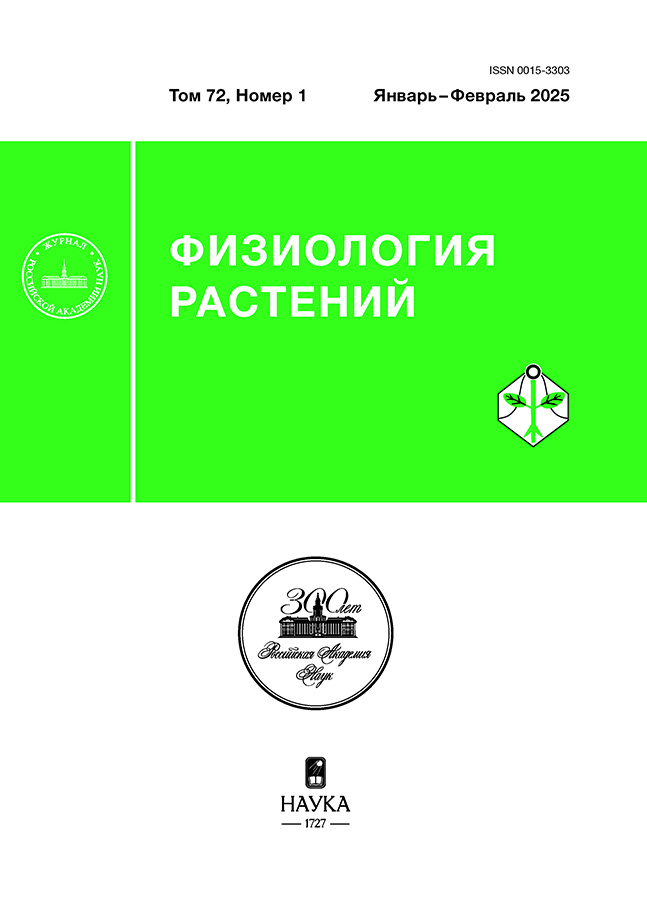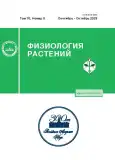Кратковременная предобработка мелатонином повышает устойчивость растений ячменя к последующему действию кадмия
- Авторы: Данилова Е.Д.1, Злобин И.Е.1,2, Ефимова М.В.1
-
Учреждения:
- Федеральное государственное автономное образовательное учреждение высшего образования “Национальный исследовательский Томский государственный университет”
- Федеральное государственное бюджетное учреждение науки Институт физиологии растений им. К.А. Тимирязева Российской академии наук
- Выпуск: Том 70, № 5 (2023)
- Страницы: 484-493
- Раздел: ЭКСПЕРИМЕНТАЛЬНЫЕ СТАТЬИ
- URL: https://journals.rcsi.science/0015-3303/article/view/139779
- DOI: https://doi.org/10.31857/S0015330323600225
- EDN: https://elibrary.ru/WWXHRG
- ID: 139779
Цитировать
Полный текст
Аннотация
Исследовано влияние кратковременной и длительной прикорневой обработки мелатонином на ростовые параметры, фотохимическую активность ФС II, содержание основных фотосинтетических пигментов, перекисное окисление липидов и накопление неорганических ионов в растениях ячменя на фоне действия хлорида кадмия. Впервые показано, что защитное действие фитомелатонина при кратковременной обработке проявляется в снижении токсического действия кадмия на содержание фотосинтетических пигментов и накопление ионов кадмия в побегах и корнях растений ячменя. В основе протекторного действия мелатонина лежит его способность снижать интенсивность окислительного стресса за счет поддержания уровня каротиноидов и повышения активности антиоксидантных ферментов. Эффективность кратковременного применения мелатонина по ряду показателей превосходит его защитный эффект от длительного воздействия. Полученные данные свидетельствуют о возможности применения мелатонина в качестве вещества, индуцирующего состояние прайминга растений при последующем действии кадмия.
Ключевые слова
Об авторах
Е. Д. Данилова
Федеральное государственное автономное образовательное учреждение высшего образования“Национальный исследовательский Томский государственный университет”
Email: nusy.l.d@gmail.com
Россия, Томск
И. Е. Злобин
Федеральное государственное автономное образовательное учреждение высшего образования“Национальный исследовательский Томский государственный университет”; Федеральное государственное бюджетное учреждение науки
Институт физиологии растений им. К.А. Тимирязева Российской академии наук
Email: nusy.l.d@gmail.com
Россия, Томск; Россия, Москва
М. В. Ефимова
Федеральное государственное автономное образовательное учреждение высшего образования“Национальный исследовательский Томский государственный университет”
Автор, ответственный за переписку.
Email: nusy.l.d@gmail.com
Россия, Томск
Список литературы
- Clemens S., Ma J.F. Toxic heavy metal and metalloid accumulation in crop plants and foods // Annu. Rev. Plant Biol. 2016. V. 67. P. 489. https://doi.org/10.1146/annurev-arplant-043015-112301
- Srivastava V., Sarkar A., Singh S., Singh P., de Araujo A.S.F., Singh R. Agroecological responses of heavy metal pollution with special emphasis on soil health and plant performances // Front. Environ. Sci. 2017. V. 5. P. 1. https://doi.org/10.3389/fenvs.2017.00064
- Danilova E.D., Zlobin I.E., Kuznetsov V.V., Efimova M.V. Exogenic melatonin reduces the toxic effect of polymetallic stress on barley plants // Dokl. Biochem. Biophys. 2021. V. 499. P. 228. https://doi.org/10.1134/S1607672921040049
- Asgher M., Khan M.I.R., Anjum N.A., Khan N.A. Minimising toxicity of cadmium in plants – role of plant growth regulators // Protoplasma. 2015. V. 252. P. 399. https://doi.org/10.1007/s00709-014-0710-4
- Muradoglu F., Gundogdu M., Ercisli S., Encu T., Balta F., Jaafar H., Zia-Ul-Haq M. Cadmium toxicity affects chlorophyll a and b content, antioxidant enzyme activities and mineral nutrient accumulation in strawberry // Biological Res. 2015. V. 48. P. 1. https://doi.org/10.1186/s40659-015-0001-3
- Cho U.H., Seo N.H. Oxidative stress in Arabidopsis thaliana exposed to cadmium is due to hydrogen peroxide accumulation // Plant Sci. 2005. V. 168. P. 113. https://doi.org/10.1016/j.plantsci.2004.07.021
- Hussain I., Iqbal M., Qurat-Ul-Ain S., Rasheed R., Mahmood S., Perveen F., Wahid A. Cadmium dose and exposure-time dependent alterations in growth and physiology of maize (Zea mays) // Int. J. Agric. Biol. 2012. V. 14. P. 959.
- El Rasafi T., Oukarroum A., Haddioui A., Song H., Kwon E.E., Bolan N., Tack F.M.G., Sebastian A., Prasad M.N.V., Rinklebe J. Cadmium stress in plants: a critical review of the effects, mechanisms, and tolerance strategies // Crit. Rev. Environ. Sci. Technol. 2020. P. 1. https://doi.org/10.1080/10643389.2020.183543
- Bian M., Zhou M., Sun D., Li C. Molecular approaches unravel the mechanism of acid soil tolerance in plants // Crop J. 2013. V. 1. P. 91. https://doi.org/10.1016/j.cj.2013.08.002
- Arnao M.B., Hernandez-Ruiz J. Functions of melatonin in plants: a review // J. Pineal Res. 2015. V. 59. P. 133. https://doi.org/10.1111/jpi.12253
- Zhang Y.P., Yang S.J., Chen Y.Y. Effects of melatonin on photosynthetic performance and antioxidants in melon during cold and recovery // Biol. Plant. 2017. V. 61. P. 571. https://doi.org/10.1007/s10535-017-0717-8
- Kholodova V.P., Vasil’ev S.V., Efimova M.V., Voronin P.Yu., Rakhmankulova Z.F., Danilova E.Yu., Kuznetsov Vl.V. Exogenous melatonin protects canola plants from toxicity of excessive copper // Russ. J. Plant Physiol. 2018. T. 65. P. 882. https://doi.org/10.1134/S1021443718060080
- Nawaz M.A., Jiao Y., Chen C., Shireen F., Zheng Z., Imtiaz M., Bie Z., Huang Y. Melatonin pretreatment improves vanadium stress tolerance of watermelon seedlings by reducing vanadium concentration in the leaves and regulating melatonin biosynthesis and antioxidant-related gene expression // J. Plant Physiol. 2018. V. 220. P. 115. https://doi.org/10.1016/j.jplph.2017.11.003
- Savvides A., Ali S., Tester M., Fotopoulos V. Chemical priming of plants against multiple abiotic stresses: mission possible? // Trends Plant Sci. 2016. V. 21. P. 329. https://doi.org/10.1016/j.tplants.2015.11.003
- Blamey F.P.C., Hernandez-Soriano M.C., Cheng M., Cheng M., Tang C., Paterson D.J., Lombi E., Wang W.H., Scheckel K.G., Kopittke P.M. Synchrotron-based techniques shed light on mechanisms of plant sensitivity and tolerance to high manganese in the root environment // Plant Physiol. 2015. V. 169. P. 2006. https://doi.org/10.1104/pp.15.00726
- Danilova E.D., Litvinovskaya R.P., Zlobin I.E., Kolomeichuk L.V., Murgan O.K., Sauchuk A.L., Khripach V.A., Kuznetsov V.V., Efimova M.V. Polymetallic stress changes the endogenous status of brassinosteroids and reduces the effectiveness of photochemical reactions photosystem II in barley plants // Dokl. Biochem. Biophys. 2022. V. 504. P. 123. https://doi.org/10.1134/S1607672922030024
- Kopittke P.M., Blamey F.P.C., Asher C.J., Menzies N.W. Trace metal phytotoxicity in solution culture: a review // J. Exp. Bot. 2010. V. 61. P. 945. https://doi.org/10.1093/jxb/erp385
- Li Z., Wang P., Menzies N.W., Kopittke P.M. Defining appropriate methods for studying toxicities of trace metals in nutrient solutions // Ecotoxicol. Environ. Saf. 2018. V.147. P. 872. https://doi.org/10.1016/j.ecoenv.2017.09.044
- Аникеев В.В., Кутузов Ф.Ф. Новый способ определения листовой поверхности у злаков // Физиология растений. 1961. Т. 8. С. 375.
- Buege J.A., Aust S.D. Microsomal lipid peroxidation // Biomembrans. 1978. V. 52. P. 302. https://doi.org/10.1016/s0076-6879(78)52032-6
- Lichtenthaler H.K. Chlorophylls and carotenoids: pigments of photosynthetic biomembranes // Plant Cell. 1987. P. 350. https://doi.org/10.1016/0076-6879(87)48036-1
- Bates L.S., Waldren R.P., Teare I.D. Rapid determination of free proline for water-stress studies // Plant Soil. 1973. V. 39. P. 205. https://doi.org/10.1007/BF00018060
- Beauchamp C., Fridovich I. Superoxide dismutase improved assays and an assay applicable to acrylamide gels // Anal. Biochem. 1971. V. 44. P. 276. https://doi.org/10.1016/0003-2697(71)90370-8
- Shevyakova N.I., Stetsenko L.A., Meshcheryakov A.B., Kuznetsov Vl.V. The activity of the peroxidase system in the course of stress-induced CAM development // Russ. J. Plant Physiol. 2002. V. 49. P. 598. https://doi.org/10.1023/A:1020224531599
- Esen A.A. Simple method for quantitative, semiquantitative, and qualitative assay of protein // Anal. Biochem. 1978. V. 89. P. 264. https://doi.org/10.1016/0003-2697(78)90749-2
- Ruban A.V. Nonphotochemical chlorophyll fluorescence quenching: mechanism and effectiveness in protecting plants from photodamage // Plant Physiol. 2016. V. 170. P. 1903. https://doi.org/10.1104/pp.15.01935
- Yan H., Jia S., Mao P. Melatonin priming alleviates aging-induced germination inhibition by regulating β-oxidation, protein translation, and antioxidant metabolism in oat (Avena sativa L.) seeds // Int. J. Mol. Sci. 2020. V. 21. P. 1. https://doi.org/10.3390/ijms21051898
- Mehta V., Kansara R., Srivashtav V., Savaliya P. A novel insight into phytoremediation of heavy metals through genetic engineering and phytohormones // J. Nanosci. Nanomed. Nanobio. 2021. V. 4. P. 1.
- Sadak M.S., Abdalla A.M., Abd Elhamid E.M., Ezzo M.I. Role of melatonin in improving growth, yield quantity and quality of Moringa oleifera L. plant under drought stress // Bull. Natl. Res. Cent. 2020. V. 44. P. 1.
- Danilova E.D., Efimova M.V., Kolomeichuk L.V., Kuznetsov V.V. Melatonin supports photochemical activity of assimilation apparatus and delays senescence of leaves of monocotyledonous plants // Dokl. Biochem. Biophys. 2020. V. 495. P. 271. https://doi.org/10.1134/S1607672920050051
- Wang L.Y., Liu J.L., Wang W.X., Sun Y. Exogenous melatonin improves growth and photosynthetic capacity of cucumber under salinity-induced stress // Photosynthetica. 2016. V. 54. P. 19. https://doi.org/10.1007/s11099-015-0140-3
- Zhang Y.P., Yang S.J., Chen Y.Y. Effects of melatonin on photosynthetic performance and antioxidants in melon during cold and recovery // Biol. Plant. 2017. V. 61. P. 571. https://doi.org/10.1007/s10535-017-0717-8
- Sharma A., Zheng B. Melatonin mediated regulation of drought stress: physiological and molecular aspects // Plants. 2019. V. 8. P. 1. https://doi.org/10.3390/plants8070190
- Hoqu M., Tahjib-Ul-Arif M., Hannan A., Sultana N., Akhter S., Hasanuzzaman M., Akter F., Hossain M.S., Sayed M.A., Hasan M.T., Skalicky M., Li X., Brestic M. Melatonin modulates plant tolerance to heavy metal stress: Morphological responses to molecular mechanisms // Int. J. Mol. Sci. 2021. V. 22. № 21. P. 1. https://doi.org/10.3390/ijms222111445
- Xu L., Zhang F., Tang M., Wang Y., Dong J., Ying J., Chen Y., Hu B., Li C., Liu L. Melatonin confers cadmium tolerance by modulating critical heavy metal chelators and transporters in radish plants // J. Pin. Res. 2020. V. 69. P. 1. https://doi.org/10.1111/jpi.12659
- Jiang M., Dai S., Wang B., Xie Z., Li J., Wang L., Li S., Tana Y., Tian B., Shu Q., Huang J. Gold nanoparticles synthesized using melatonin suppress cadmium uptake and alleviate its toxicity in rice // Enviro. Sci. Nano. 2021. V. 8. P. 1042.
- Amjadi Z., Namdjoyan S., Soorki A.A. Exogenous melatonin and salicylic acid alleviates cadmium toxicity in safflower (Carthamus tinctorius L.) seedlings // Ecotoxicol. 2021. V. 30. P. 387. https://doi.org/10.1007/s10646-021-02364-y
- Hasan M.K., Ahammed G.J., Sun S., Li M., Yin H., Zhou J. Melaton ininhibits cadmium translocation and enhances plant tolerance by regulating sulfur uptake and assimilation in Solanum lycopersicum L. // J. Agric. Food Chem. 2019. V. 67. P. 10563. https://doi.org/10.1021/acs.jafc.9b0240
Дополнительные файлы
















